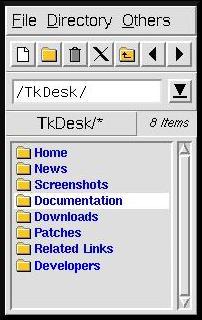
Download Current Version: tkdesk-1.2.tar.gz


Download Current Version:
tkdesk-1.2.tar.gz
Next
Previous
Contents
4. File Operations
4.1 File Information
The "File Information" window displays detailed information about a file. It can also be used to change the owner or access-permissions of a file. In addition, an annotation to a file can be added here. The following information is displayed:
In the "Annotation" text field you can enter any remarks about the file. This annotation will be saved when the "Close" button is pressed. Files having annotations attached to them will appear underlined in the file listboxes, and their popup menu will contain the first few words of that annotation as an "informative" menu entry. If the window displays information about a file an additional button labeled "Disk Usage" is provided, which calculates the disk usage of the hierarchy rooted at that directory. The entries of the "Disk Usage" window can be double-clicked to open new file list windows.
4.2 Copying, Moving and Deleting Files
These functions can be accessed from the "File" menu, among others. There is one dialog for copying, moving and linking files (plus an arbitrary number of user-defined actions such as diff and patch, as configured in the "Popups" config file), one dialog for renaming files (which does nothing else than moving the file to its new name), and one dialog for deleting files. The "Rename" dialog is very straight-forward and probably does not need further explanation. The "Copy etc." dialog contains the obvious source and destination entry fields, plus a checkbutton labeled "all selected files" if more that one file was selected when this dialog was opened. If this checkbutton is selected (default) the operation will be applied on all selected files. If it is not checked, each file will be handled individually. The "Skip" button can then be used for skipping individual files. The "Delete" dialog also contains this checkbutton, plus a checkbutton labeled "Delete permanently". If this checkbutton is selected, the files will not be moved to the trash can but will be really and ultimately deleted!! The default setting of this checkbutton can be set from the "Options" menu.
4.3 Finding Files
The "File" menu contains two entries for finding files: "Find Files..." and "Find Annotation...". Files can be annotated through their "Info" dialog (accessible from the "File" menu or from their popup menu), see section File Information. "Find Annotation" enables you to look for an annotated file whose annotation matches a certain regular expression (which can be as simple as an ordinary string). "Find Files" lets you look for files (or rather: let's you instruct TkDesk to look for files) whose names match one or multiple patterns, which are of a certain type (such as directory), which contain a certain string, which are smaller or bigger than a certain number of kilobytes or which are younger/older than a certain date. All fields which are not left blank in this dialog will be combined with a logical AND. This dialog is currently the only one utilizing the balloon help capability of TkDesk, so for now I would like to refer you to this. For instance, if you want to know how to enter the file size you're looking for, place the mouse pointer over the "Size" entry field without moving it for a few seconds. Both "Find" dialogs display their results in the same file listboxes that are used by the file list and browser windows, so the same bindings described in section Handling of the Listboxes (Bindings) apply here as well!
Next Previous Contents |
Maintainer: J. Chris Coppick